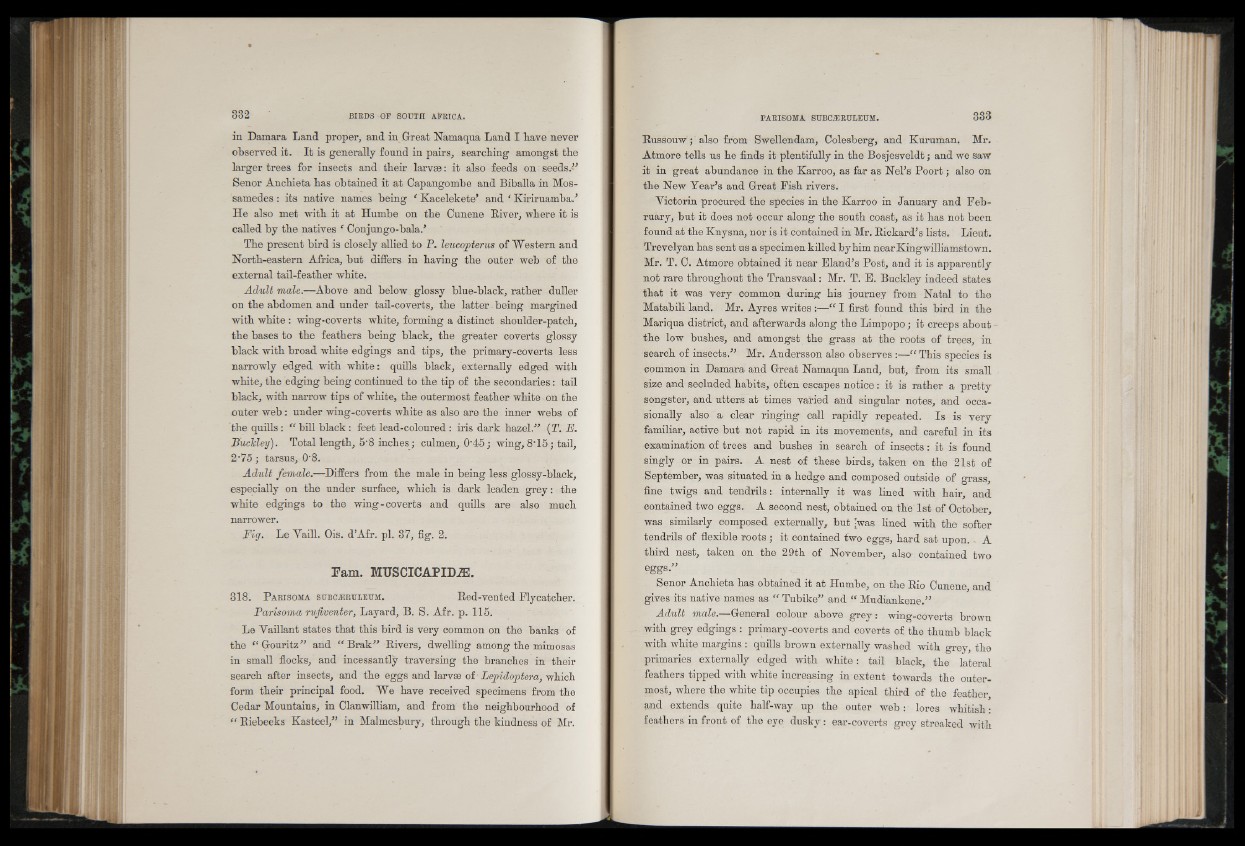
in Darnara Land proper, and in .Great Namaqua Land I have never
observed it. It is generally found in pairs, searching amongst the
larger trees for insects and their larvae: it also feeds on seeds.”
Senor Anchieta has obtained it at Oapangombe and Biballa in Mos-
samedes : its native names being ‘ Kacelekete’ and ‘ Kiriruamba.’
He also met with it at Humbe on the Cunene River, where it is
called by the natives ‘ Conjungo-bala.’
The present bird is closely allied to P. leucojpterus of Western and
North-eastern Africa, but differs in having the outer web of the
external tail-feather white.
Adult male.—Above and below glossy blue-black, rather duller
on the abdomen and under tail-coverts, the latter. being margined
with white : wing-coverts white, forming a distinct shoulder-patch,
the bases to the feathers being black, the greater coverts glossy
black with broad white edgings and tips, the primary-coverts less
narrowly edged with white: quills black, externally edged with
white, the edging being continued to the tip of the secondaries: tail
black, with narrow tips of white, the outermost feather white • on the
outer web : under wing-coverts white as also are the inner webs of
the quills: “ bill black: feet lead-coloured : iris dark hazel.'’'’ (T. E.
Bucldey). Total length, 5'8 inches; culmen, 0'45; wing, 8" 15; tail,
2-75; tarsus, 0’8.
Adult female.—Differs from the male in being less glossy-black,
especially on the under surface, which is dark leaden grey: the
white edgings to the wing-coverts and quills are also much
narrower.
Fig. Le Vaill. Ois. d’Afr. pi. 37, fig. 2.
Fam. MTJSCICAPID2E.
318. P abisoma subc^ ruleum . Red-vented Flycatcher.
Parisoma rufiventer, Layard, B. S. Afr. p. 115.
Le Yaillant states that this bird is very common on the banks of
the “ Gouritz” and “ Brak” Rivers, dwelling among the mimosas
in small flocks, and incessantly traversing the branches in their
search after insects, and the eggs and larvae of Lepidoptera, which
form their principal food. We have received specimens from the
Cedar Mountains, in Clanwilliam, and from the neighbourhood of
“ Riebeeks Kasteel,” in Malmesbury, through the kindness of Mr.
Russouw; also from Swellendam, Colesberg, and Kuruman. Mr.
Atmore tells us he finds it plentifully in the Bosjesveldt; and we saw
it in great abundance in the Karroo, as far as Nel’s Poort; also on
the New Year’s and Great Fish rivers.
Yictorin procured the species in the Karroo in January and February,
but it does not occur along the south coast, as it has not been
found at the Knysna, nor is it contained in Mr. Rickard’s lists. Lieut.
Trevelyan has sent us a specimen killed by him near Kingwilliamstown.
Mr. T. C. Atmore obtained it near Eland’s Post, and it is apparently
not rare throughout the Transvaal: Mr. T. E. Buckley indeed states
that it was very common during his journey from Natal to the
Matabili land. Mr. Ayres writes ;—“ I first found this bird in the
Mariqua district, and afterwards along the Limpopo; it creeps about
the low bushes, and amongst the grass at the roots of trees, in
search of insects.” Mr. Andersson also observes :—“ This species is
common in Damara and Great Namaqua Land, but, from its small
size and secluded habits, often escapes notice: it is rather a pretty
songster, and utters at times varied and singular notes, and occasionally
also a clear ringing call rapidly repeated. Is is very
familiar, active but not rapid in its movements, and careful in its
examination of trees and bushes in search of insects: it is found
singly or in pairs. A nest of these birds, taken on the 21st of
September, was situated in a hedge and composed outside of grass,
fine twigs and tendrils: internally it was lined with hair, and
contained two eggs. A second nest, obtained on the 1st of October,
was similarly composed externally, but [was lined with the softer
tendrils of flexible roots ; it contained two eggs, hard sat upon. - A
third nest, taken on the 29th of November, also- contained two
eggs.”
Senor Anchieta has obtained it at Humbe, on the Rio Cunene and
gives its native names as “ Tubike” and “ Mudiankene.”
Adult male.—General colour above grey: wing-coverts brown
with grey edgings : primary-coverts and coverts of the thumb black
with white margins : quills brown externally washed with grey, the
primaries externally edged with white: tail black, the lateral
feathers tipped with white increasing in extent towards the outermost,
where the white tip occupies the apical third of the feather,
and extends quite half-way up the outer web: lores whitish:
feathers in front of the eye dusky: ear-coverts grey streaked with